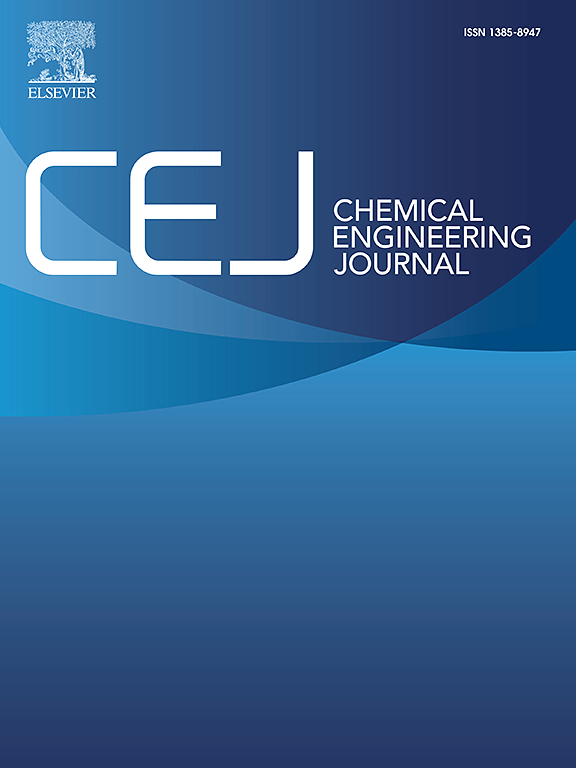Oxygen vacancies-rich bimetallic Zr/Co-UiO-66 materials for bifunctional adsorption-photodegradation of tetracycline antibiotics in water
IF 13.2
1区 工程技术
Q1 ENGINEERING, CHEMICAL
引用次数: 0
Abstract
As broad-spectrum antibiotics, tetracycline antibiotics (TCs) have been extensively utilized in aquaculture and agricultural production processes. However, the misuse of TCs has led to severe ecological pollution and posed significant risks to human health. The adsorption-photocatalytic synergistic technology based on metal-organic framework materials (MOFs) is considered a highly promising strategy for the efficient removal of organic pollutants. In this study, a bimetallic Zr/Co-UiO-66 framework material with dual adsorption and photocatalytic functionalities was synthesized, targeting the removal of TCs from water. This material exhibited a high specific surface area and abundant oxygen vacancies (OVs), which facilitated rapid adsorption of contaminants and efficient separation and transfer of the carriers. Compared to the monometallic framework Zr-UiO-66, the bimetallic framework demonstrated superior adsorption (5.13-fold) and photocatalytic efficiency (2.21-fold). The adsorption behavior of oxytetracycline (OTC) by Zr/Co-UiO-66 fitted well with the Freundlich isotherm model and followed the pseudo-second-order kinetic model. The synergistic effect of adsorption and photocatalysis (1.72-fold increase in kinetic rate) was verified by comparison with sequential adsorption-degradation processes. The photocatalytic degradation mechanism for OTC was elucidated, and the degradation intermediates and five pathways were identified through LC-MS analysis. The bimetallic Zr/Co-UiO-66 achieved high degradation efficiency (90.7 %–97.9 %) for TCs and exhibited broad-spectrum activity, good long-term operational stability and recyclability. This study proposes a robust and referential method for the development of multi-functionalized framework materials that facilitates the efficient removal of pollutants from environmental samples.

富氧空位双金属Zr/Co-UiO-66材料双功能吸附-光降解水中四环素类抗生素
四环素类抗生素作为广谱抗生素,在水产养殖和农业生产过程中得到了广泛的应用。然而,滥用氯代烃造成了严重的生态污染,对人类健康构成了重大风险。基于金属-有机骨架材料(MOFs)的吸附-光催化协同技术被认为是一种非常有前途的高效去除有机污染物的策略。本研究合成了一种具有双重吸附和光催化功能的双金属Zr/Co-UiO-66框架材料,以去除水中的tc为目标。该材料具有高比表面积和丰富的氧空位(OVs),有利于污染物的快速吸附和载体的高效分离和转移。与单金属框架Zr-UiO-66相比,双金属框架具有更好的吸附性能(5.13倍)和光催化效率(2.21倍)。Zr/Co-UiO-66吸附土霉素(OTC)的行为符合Freundlich等温线模型,符合拟二级动力学模型。通过与顺序吸附-降解过程的比较,验证了吸附与光催化的协同作用(动力学速率提高1.72倍)。阐明了OTC的光催化降解机理,并通过LC-MS分析鉴定了降解中间体和5条途径。双金属Zr/Co-UiO-66对TCs具有较高的降解效率(90.7 % ~ 97.9% %),具有广谱活性、良好的长期运行稳定性和可回收性。本研究为开发多功能框架材料提供了一种可靠的参考方法,有助于有效地去除环境样品中的污染物。
本文章由计算机程序翻译,如有差异,请以英文原文为准。
求助全文
约1分钟内获得全文
求助全文
来源期刊

Chemical Engineering Journal
工程技术-工程:化工
CiteScore
21.70
自引率
9.30%
发文量
6781
审稿时长
2.4 months
期刊介绍:
The Chemical Engineering Journal is an international research journal that invites contributions of original and novel fundamental research. It aims to provide an international platform for presenting original fundamental research, interpretative reviews, and discussions on new developments in chemical engineering. The journal welcomes papers that describe novel theory and its practical application, as well as those that demonstrate the transfer of techniques from other disciplines. It also welcomes reports on carefully conducted experimental work that is soundly interpreted. The main focus of the journal is on original and rigorous research results that have broad significance. The Catalysis section within the Chemical Engineering Journal focuses specifically on Experimental and Theoretical studies in the fields of heterogeneous catalysis, molecular catalysis, and biocatalysis. These studies have industrial impact on various sectors such as chemicals, energy, materials, foods, healthcare, and environmental protection.
 求助内容:
求助内容: 应助结果提醒方式:
应助结果提醒方式:


